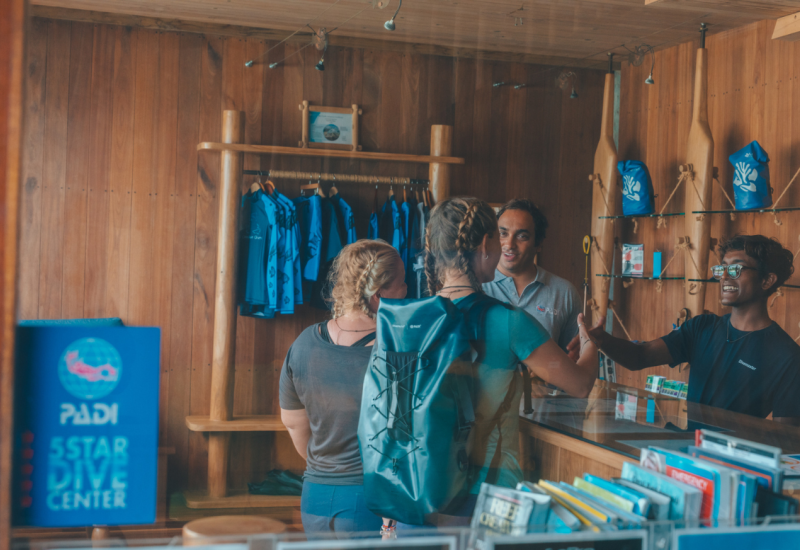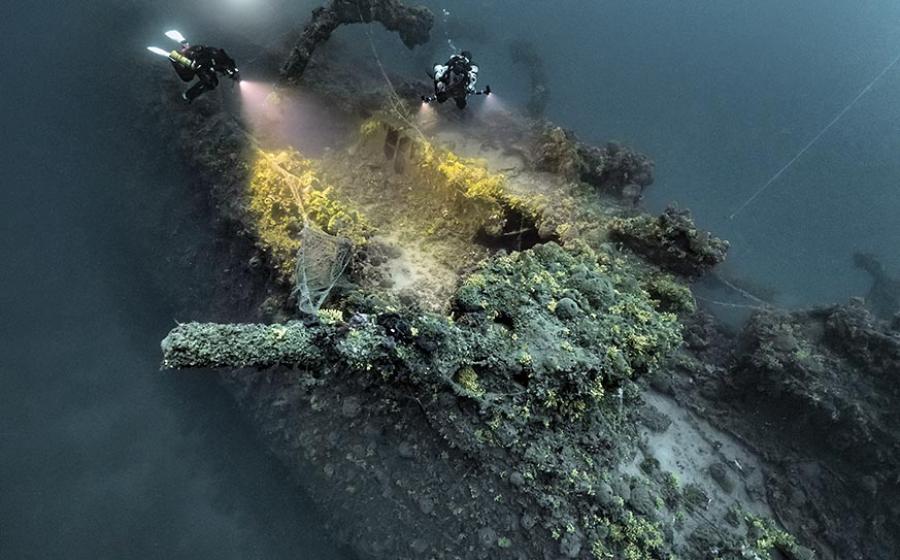Oman Aggressor Liveaboard Travel Guide
Poised on the verge of our third dive of the day, we gaze off the deck of Oman Aggressor at Mirbat, a dusty town that, a thousand years ago, served the region’s frankincense trade, and later was known for the fine Arabian horses bred here.
It seems clear Mirbat’s glory days are behind it — until we submerge.
Scuba is relatively new on Oman’s southern coast, so there’s little knowledge of the site we are about to dive, called the Marriott Wreck after a nearby local landmark.
“We know it’s old because it takes a long time for hard coral to cover metal,” cruise director Shaker Mohamed briefs us, marveling that “there’s more coral on this than on the Carnatic,” a famed Red Sea wreck that went down in 1869. Like most of the crew, Mohamed learned his craft on Red Sea liveaboards, so he knows what he’s talking about.
He didn’t exaggerate — coral coverage appears near total on the mostly flattened, colorful wreck. The welcoming committee greets us right away — a flock of fluttering squid at the mooring line.

Scott JohnsonVariable-Lined Fusiliers
Moving south along the shallow wreck — max depth is around 33 feet — we encounter big stationary schools of sweepers, mono, snapper and sweetlips, packed like sardines from sand to surface. The broken-up remains create endless nooks, crannies and hidey-holes for eels, shrimp, cuttlefish, nudis, rays, fusiliers, a crocodilefish and vast numbers of parrotfish — so much to look at, we might have stayed all day (and at these depths, we almost could).
We circle out to the end of the nearly 200-foot wreck, where a giant anchor lies in the sand. Meandering back along the port side, we find a huge honeycomb moray and, under a beam, the loveliest pair of endemic Arabian butterflyfish, which aren’t at all concerned with me or my camera.
Between the thrill of the unknown, the dramatic density of life here and that giddy feeling of having a dive site — or dozens — all to yourself, all I can think is, What a privilege just to be here.

Scott JohnsonThe Eastern coast of Salalah, Oman.
Need to Know
When to Go: Oman Aggressor dives the Hallaniyat Islands October through April; May through September it is based in Muscat and dives the Gulf of Oman and the Musandam Peninsula.
Travel Tip: Qatar Airways and Emirates Airline fly direct from U.S. hubs to Doha and Dubai. Salalah is about a two-hour flight from either. Oman requires an entrance visa — around $50 USD — that should be procured before you depart.
Dive Conditions: Conditions vary with the season. Water temps might be cooler — in the low 70s — and currents milder in winter, with viz from 20 to 100 feet; a 5 mm fullsuit or greater, along with gloves and a hood, is desirable. Spring brings better viz but stronger currents.
Operator: Sleek, 148-foot Oman Aggressor (aggressor.com) has a beam of 28 feet; it carries 13 crew and up to 22 passengers in 11 staterooms with single and king beds — not bunks — and en suite baths. Diving is from the mothership and two 23-foot pangas.
Price Tag: Through 2019, seven-night cruises start at $2,416 and 10-night cruises at $3,186; itineraries can be combined. Aggressor Travel can help you book additional land excursions before or after your trip.

Courtesy Aggressor LiveaboardsLiving the luxe life aboard Oman Aggressor
Luxe Life
Push open the door between Oman Aggressor’s main outdoor lounge and its salon, and you might get a surprise. Stepping inside the yacht is like arriving at a chic boutique hotel in a European capital: rich dark woods, white couches, white plush rugs, gleaming glass and chrome everywhere.
It’s the first liveaboard I’ve seen where guests consistently approach the buffet with a plate in one hand and a camera in the other. The yacht’s imposing chef and equally formidable pastry chef loom in silence behind the serving table, arms crossed like the stone colossi that guard the tombs of their native Egypt. But they’re all warm smiles and shy thanks at the exclamations from delighted guests — a “scuba cake” with divers and undersea creatures rendered in brilliant fondant nearly steals the show from the chef’s elaborate “Thanksgiving” turkey, a Thursday-night tradition on many Aggressor yachts.

Scott JohnsonBluespotted Ribbontail Ray
Our hosts for all this are the lively 13-person crew. Friendly and eager to please, they rush to assist in any way we need or want. All briefings are done in the salon with the help of two large-screen high-def TVs; between the comfort and elegance inside and the warm sun and cool breezes outside — a hot tub on the sun deck is filled on demand — it’s a wonder some days that anybody is diving at all. Little touches abound, from the 24 power outlets on the dive deck’s spacious camera tables to the preference cards the steward collects to inform the chef and cruise director of our smallest whims.
The diving in the Hallaniyat Islands, roughly 100 miles east of the yacht’s seasonal departure port in Salalah, is rewarding without being so challenging that you’re tempted to just keep enjoying that gorgeous salon. While currents can be strong and changeable, the crew does a super job keeping us out of them. Tender rides are short — mostly five to seven minutes — and dive sites average about 75 feet.
Yes, there are humpbacks in the Hallaniyats, an elusive Arabian Sea pod so isolated that some scientists believe it might represent an entirely new subspecies. And, no, odds are you will not see them. But I would absolutely-almost-totally-pinky-swear I heard them on our last dive of the trip. (Consolation prize: two encounters with a 20-foot juvenile whale shark at the same site, on our first dive of the weeklong cruise.)

Scott JohnsonA Zebra Shark, so named because the juveniles are striped.
What you will see is a wondrous parade of endemics and creatures unfamiliar to North American divers: zebra sharks, dragon morays, giant marbled stingrays, and cowries beyond count — a shell expert among the guests opens our eyes to the lovely world of the family Cypraeidae, once valued as currency by cultures from Africa to China. Even familiar creatures — nudis, eels, rays and scorpionfish — seem bigger here, and more numerous and varied. There’s healthy hard coral everywhere — a welcome sight in any ocean, these days — as well as small forests of soft coral, short in stature but mighty in their profusion of hues.
And don’t discount the enrichment offered by your fellow travelers. As Oman itself has for thousands of years, Oman Aggressor counts a rainbow of nations among its guests. On our cruise, divers from nine countries spanning 6,000 miles and seven tongues found the yacht a safe and fun place to explore our differences and commonalities — and, really, isn’t that also why we’re here? To discover more about the world around us, and to know ourselves better in the process.

Scott JohnsonThe Eastern coast of Salalah, Oman.
Treasures Old and New
Sailing Oman Aggressor’s Hallaniyat Islands itinerary gives you the chance to explore sites laden with historical significance.
Not one but two UNESCO World Heritage Sites are within striking distance of Salalah, one of Oman Aggressor’s two home ports. At Sumhuram — an archaeological park 25 miles east of Salalah — the frankincense trade flourished for nearly a thousand years, from about 400 B.C. to A.D. 500. Visitors will find a partially excavated fortified port with excellent signage and spectacular views. In the heart of Salalah is Al-Baleed, which supported the trade from about 800 to 1600. Today it’s home to a fascinating maritime museum and a vast, active archaeological site. Although Oman is a Muslim country, it hosts several sites of biblical significance. Those with an interest in Old Testament history can visit what’s said to be Job’s tomb, near Salalah, and search for the remains of a palace of the Queen of Sheba — who may have gifted Solomon with Oman frankincense — near Sumhuram.
You also can get a taste of the Middle East without leaving the new Hawana Salalah Marina, where the yacht is berthed. Multiple hotels and a crescent-shaped shopping and dining area that comes alive at dusk surround a sculpted lagoon with a centerpiece island bar, blending European-style amenities with the aesthetics of the Arabian Peninsula.
A Privilege Indeed
Sunrise grows more beautiful each morning, as the rising moon becomes a crescent, then a hairline, waning with the days of our trip. Saturn, Mars, Jupiter and Scorpio sparkle against a dark curtain that rises to reveal the hardscrabble face of these islands, forbidding but beautiful. At Al Qibliyah, the easternmost point of our cruise, a thin layer of nectarine outlines peaks more jagged and fanciful than any so far. It’s gorgeous. Unforgettable.
Suddenly, my reverie is disturbed by a loud and heated argument. It’s not until we submerge at a site called Gotta Qibliyah that I realize what it was: seabirds in a nearby cave, scolding one another.
We drop into a trench almost on top of a beautiful little cowrie galloping across a flat rock; exiting the trench, we see a mobula ray going one way and a big loggerhead going the other. Just outside the trench is the edge of a small seamount, with boulders nearly as large strewn about, and big schools of fish just hanging out — two-bar bream, bass and a few bigger fish, possibly Malabar grouper, that seem to shepherd them.
At the base of a small wall, we spy a triangular opening and in we go — inside is an arched passage, natural light reflecting off its walls, that feels like swimming through a cathedral nave. The passage leads us back around the seamount to where we started, where Mohamed points out a dragon moray.
Rising to our safety stop, we encounter a field of pulsing poppies — small jellies, actually, a delicate pink with darker accents, and a tiny fish inside most. Beautiful, mesmerizing — a privilege indeed.











